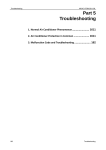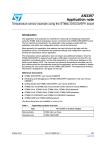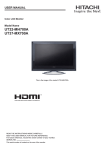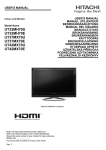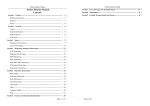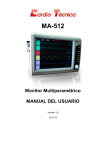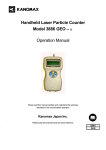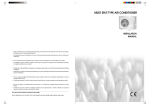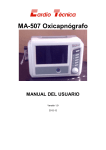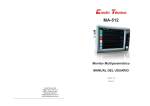Download User Manual
Transcript
Capnograph and Oximeter CapOx User Manual VirtuOx VPOD CapOx Instructions to User VPOD CapOx Thank you very much for purchasing our product. This manual includes the materials and copyright reserved. It is not allowed to copy, reduplicate or translate into other languages without our written permission. Please to read this manual carefully and then to operate by the instruction of this manual. It is not allowed to open the monitor’s cover without our permission. Some changes on the product due to the technologies’ promotion or due to the special demands of user which do not influence the monitor’s work will not be informed further. Furthermore please pay attention to the difference between the parts or components and this manual. You may apply to our company for technical documents about the electric circuit diagram relevant batch and lists of parts or components and so on because the continuous promotion of the product. You may contact us by means of the following address. CONTENTS 1 VPOD CapOx Chapter I Preface......................................................................…… ....................2 Chapter II Technical specifications and characteristics ..................................4 Chapter III Introduction of Monitor .....................................................................6 Chapter IV Patient connection ............................................................................7 Chapter V Screen display and Operation ........................................................ 13 Chapter VI Charge, Maintenance, sterilization, cleanness ............................ 23 Chapter VII Analysis of problems .....................................................................25 Appendix 1. Explications for the appreciated terms .....................................28 Appendix 2. Changing compensation of balance gas ...................................29 Appendix 3. Calibrating of EtCO2 precision ...................................................30 2 VPOD CapOx Chapter I Preface I. Brief The purpose of this manual is for quick understanding of characteristics, functions, operation of the monitor, preventing from mal-operation and mistakes. This monitor can supervise four physical parameters of patient at the same time: concentration of EtCO2, respiration rate, pulse and saturation of SPO2. II. Warranty and Maintenance Warranty The CapOx comes with a standard 1 year warranty The following is out of warranty: The monitor is damaged due to bad-operation (without following the manual instruction) The monitor is managed due to incorrect connection with other instruments. The monitor is damaged due to accident. The user changes the monitor on his own will without written authority of the company. The serial number is torn off or unreadable. Maintenance If the monitor is broken beyond warranty period, the manufacturer or distributor will fix it with a charge. Re-packing To take out all the sensors and accessories, then to pack them in plastic bag. It is recommended to use the original packing boxes and packing materials. It is better to provide description for broken-down phenomenon. III. Safety Demand For the purpose of safety, please read the following and abide by the instruction of medical instrumental products. Warning: Indicating the possible injury on patient or operator. ·This monitor is banned to supervise patient for suffocation, and also is banned to apply during the operation of MRI or CT. 3 VPOD CapOx ·For the monitor’s safely grounding, the hospital shall provide three-pole power socket. ·To use the designated accessories, which complying with standard of manufacturer... ·It is banned to remove the cover of the monitor. ·This monitor provides Concentration of EtCO2, Respiration rate or Oximeter saturation and Pulse. These data only do auxiliary help for diagnosis but the real diagnosis shall be made by doctor through the clinical evaluation and symptoms. ·In order to keep the patient’s skin intact, the SpO2 ‘s sensor needs to reput on a new place at least every 24 hours. Chapter II Technical specifications and characteristics 1. The normal working conditions: Environment temperature: 10ć~40ć Relative humidity: 30%~75% Voltage: AC 100V~250V, Frequency: 50Hz/60 Hz Air pressure: 86kPa~106 kPa 2. Concentration of EtCO2 (see note 1) Range: 0.0-19.7% (V/V), 0-150mmHg,or 0-20kPa Accuracy: deviation˘±2mmHg when EtCO2 concentration in 0-40mmHg deviation˘±5% (reading) when EtCO2 concentration in 41-70mmHg deviation˘±8% (reading) when EtCO2 concentration in 71-100mmHg deviation ˘ ±10% (reading) when 101-150mmHg Alarm accuracy: accuracy˘±0.2% 3. Total System response time < 1second 4. Respiration rate Range: 3 ~150 times/min. Deviation: the bigger of ±1% or ±1bpm 4 EtCO2 concentration in VPOD CapOx 5. Oximeter Saturation Range: 0%̚100% Accuracy: when 50%~79%, ±3% (absolute value); when 80%~100%, ±2%(absolute value) 6. Pulse Range: 30 times/min~250times/min Deviation: when 30times/min~40times/min, ±2times/min (absolute value); when 41times/min~250times/min, ±5%(relative value) 7. Trend Parameter: EtCO2 concentration, respiration rate, SpO2 and Pulse Range: 24 hours 8. Power Demand: Voltage: AC 100V-250V, Frequency 50Hz/60 Hz, DC5V Unit Consume: ”5VA 9. Battery Battery pack 3.6Volt, 3AH Battery fully charged time: 4 hours 10. The conditions of transportation and storage: Transportation Demand: It is not allowed for striking, violent vibration and humidity. Environment temperature range: -40ć-+55ć Relative humidity range: <93% Storage demand: In a dry and good ventilating room without corrosive gas and strong magnetic field. 11. Size and weight Size: 72mm(W) x 155mm(H) x40mm(D) Weight: about 600g Note 1: The accuracy of CO2 concentration measurement is influenced by interfering gas and vapour, for example the N2O,agent can raise the CO2 reading(2-10%), and He and O2 can reduce the CO2 reading(1-10%), so compensation should be set in the balance gas MENU to meet the accuracy requirement when interfering gases exist. 5 VPOD CapOx Chapter III Introduction of Monitor I. Introduction Figure 1 (1) Screen: It can display waves, menu, alarm and all measuring parameters. (2) Ÿ/ : Function button: Ÿ a) When menu(except the TREND menu) is activated, to press this button to move cursor. b) When the TREND menu is activated, this button is to change-over switch of the trend graph and date table On the main display, to press this button to silence in 2 minutes . 6 VPOD CapOx (3) ź: To press this button to move the cursor when menu is activated. (4)Ź: To press this button to increase figures. (5)Ż: To press this button to decrease figures. (6) ENTER: Confirmation button: To press this button to enter menu. In the main menu, to press this button to turn on the pump directly when it is off. (7) To press this button to enter or quit menu. (8) Power button (9) Indicator POWER: If yellow LED is bright, the AC/DC is connected, If blue LED brightening showing the machine is working. (10) CO2: The faucet of filter (11) SpO2: The socket of SpO2 . (12) DC5V and data interface. Note: this interface is connected to device which meet safety standards (13) Exhaust outlet (14) Speaker location (15) Battery cabin (16) The hanging rope bayonet Chapter IV Patient connection I .CO2 measurement The measurement value will be more accurate if the monitor has 2 minutes’ warming-up. To connect the CO2 filter with 3-way joint of the loop of anesthetic machine by sampling tube, or to directly connect patient’s nose by the hose. 7 VPOD CapOx Figure 2 Installation of filter: alarm ˖ Do not use the capnograph when filter is not installed, so as to avoid pollution of the monitor In order to avoid breathing vapor and respiratory mucus into the module, the machine must be used with the filter T3. 8 VPOD CapOx Figure 3 .Instruction for use of the water filterT3: 1.) To put the convex cleat of Water Filter T3 into the notch of the inlet port of device and clockwise to turn it to 45°. 2.) Attach sample line to Water Filter T3 3.) To connect the other end of the sample line with breathing loop of ventilator, anesthetic machine or nasal breathing tube. 4.) Change the Water Filter T3 as needed alarm ˖ If there is leakage, measured values are likely to distortion alarm ˖Use only original sample tube, the other line measurement results may change II. Respiration rate measurement The calculation of respiration rate derives from monitoring the wave of CO2. III. Theory introduction 1 The measure principle: The device working theory is NON-DISPERSIVE INFRA GAS ANALIZER. The device has an AUTO ZERO ADJUSTMENT SYSTEM and GAIN CONTROL 2 Automatic Offset Calibrations 9 VPOD CapOx The device was designed to automatically perform calibrations in order to correct for changes in temperature, altitude and electronic component drift. At this moment, respiration wave becomes one straight line. The air surrounding the device may have elevated concentrations of CO2 present (such as in an enclosed compartment or room with poor ventilation), we recommend cleaning the CO2 from the ambient air with a ventilator, otherwise, the device will cause deviation. 3 The Moisture Separation System: This instrument uses patented filter which can filter a large number of moisture meanwhile maintain minimum dead space without affecting the waveform. But beware: too much moisture can cause congestion; The screen will show "OCCLUSION ', The operator needs to change the filter, the old filter can be reused after natural drying in ventilated and dry environment. IV. Oximeter density measurement 1. The finger oximeter sensor is recommended to use. The measurement will begin when your finger is put into the sensor clip, meanwhile, the PLETH wave will appear on the screen, after several seconds the saturation and pulse rate appear also. The monitor will utter a sound of “Di” when the each measurement happens. The tone will vary if the values of SpO2 and Pulse Rate surpass the alarm scope. The more values of SpO2 and Pulse Rate surpass the sharper the tone will do. The volume of pulse beep can be modulated and closed down by the item of BEEP VOLUME in the SOUND SET menu. The pulse beep will disappear under the silent condition. 10 VPOD CapOx Figure 4 2. The use ofSpO2 sensor for neonate The SpO2 sensor of neonate has two parts: Y-shape sensor and fixing wrapping and binding part. When it is being used, Y-shape sensor must be inset into wrapping and binding part. It should be wrapped and bound on the palm or foot of neonate. Pay attention: the two windows of Y-shape sensor should be paralleled and face to face, only in this way can the light signal emitted by light-emitting window, through the body, irradiates on the receiving window. If the two windows are not paralleled and face to face, the monitoring result may be not accurate. In addition, when SpO2 is not being monitored the probe should be taken off the monitor or the two windows of sensor should be kept face to face, otherwise the light window will keep shining and PLETH wave will be disordered and the screen will appear “FAIL SEARCH” V. Notice 1 Caution: Showing clearly possible mis-operation to the device Under the conditions of electromagnetic influence, for example: electrosurgical devices, MRI, CT etc. will cause negative impact. The filter should be taken off and replaced when it approaches full of water, otherwise too much moisture will bring irreversible damage for inner components. Be sure that the collection tube is open otherwise it will make inner sampling pump overwork and reduce pump life. 2. Attention: indicating other important information. 1). CO2: The readings will be wrong if the monitor does not warm up. The sampling tube provided by the manufacturer, shall be used, otherwise the readings may be inaccurate. Under the environment of roughly changed temperature, data measured may not be accurate. Therefore the screen will show “TEMP IMBALANCE” when quickly changed temperature overruns a certain range. It is better to use the monitor under the environment stable temperature. 11 VPOD CapOx The measured data may be influenced a little bit if the patient is inflicted by kinds of anesthetic gases. To calibrate some interferential gases if necessary. Please refer to Appendix 2. Any circumstances of blocking sampling gas, such as bending, folding, contaminations blocking sampling tube and filter or water trap etc. will lead to inaccurate measurement. 2). Oximeter: The monitor’s measurement to SpO2 may be influenced under outside strong light therefore to cover the probe (e.g. to use surgical tape etc.) if necessary. Accuracy of oximeter readings will be influenced if there is some radioactive dye in blood. Please use SpO2 probe attached with the unit or the one specially designated to this unit. It may be the problem of SoP2 probe if the SpO2 readings or the wave of plethysmogram are obviously abnormal. Therefore to check if the finger has been put into probe enough deep, if the direction is right , if the there are some contaminations inside, if the probe is somehow broken or if the two ends of prolonged cable of SpO2 fall off. Warning: It shall not be used if the sensor has some electrical wires and broken interfaces. The test of high inside pressure of thorax and blood pressure or some other continuous negative influence to venal circle will lead to vein vibration. The signal of pulse will disappear. If shock, low blood pressure, serious blood vessel shrinking, serious anemia, over low temperature, artery block near sensor and incomplete heart shrinking appear, pulse signal will disappear 12 VPOD CapOx Chapter V Screen display and Operation I. Screen main display menu Figure 5 The first line of data shows time(hour, minute)/patient ID,patient type: adult (ADU) or neonate (NEO), the memory area full indicator ď ˅ēalarm sound closing (!), silence ( ) or non silence () and battery indicator . Attention: When the full indicator for memory area displays, the data of same ID of patient can not be stored. If you want to store the new data, you need to delete the data from the memory area in the menu NEW PATIENT or to change patient’s ID. The second area shows result data: 13 VPOD CapOx EtCO2 concentration, respiratory rate, inhaling CO2 concentration, oxygen PLETH, exhaling or inhaling state (during exhaling, becomes blue color). The third area shows CO2 respiratory wave. It shows SpO2, pulse oxygen PLETH and histogram. When the pump is closed, “PUMP OFF” will appear on the screen. When the filter is not inserted into the inlet port, the screen will show ‘LINE OFF;, the pump will also be automatically closed Alarm indication: 1) If the EtCO2’s value exceeds the limit of high or low alarm level, the word ‘EtCO2’ will flash and alert with ‘Di Di’ .The same situation will happen too to respiration rate,SpO2 and pulse. 2) If the battery level is so low that the battery indicates completely empty, and monitor will utter sound continuously. At this time the monitor will be closed down automatically. 3) When the apnea alarm is turned on and the apnea happens and alerts, the screen center will appear with ‘APNEA’ (It means to stop breathing) flashing, and if the sound alarm is turned on \, it will alert ‘DI DI’. 4) When the SpO2 sensor is disconnected or off from finger, the screen will flash the word ‘SENSOR OFF’. If the saturation could not be detected for long time, the screen will flash the word ‘FAIL SEARCH’. 5) The volume of continuous or interval sound mentioned above can be modulated and closed down by the item of ALARM_VOLUME. The sound will disappear under the silent condition. If the alarm volume is 0, the silence indicator in the main menu will show '!' 6) All the parameters ' alarm for over limits and apnea alarm, will lead to flashing of red alarm indicator on the panel II. The main menu 14 VPOD CapOx Figure 6 When the main menu is open, to press the MENU button to enter the setting menu as FIGURE 6 shows. In this menu, to press Ÿ or źbutton to move the cursor up or down, To press ENTER button to enter the next son menu. This menu includes the following son menu: The setting menu for CO2: CO2_SETUP The setting menu for SpO2: SPO2_SETUP The trend menu: TREND The time menu: TIME_SETUP The sound menu: SOUND_SETUP The renew set: NEW PATIENT .To renew the new patient, Pay attention, this operation trend will be refreshed meantime so it is needed to reconfirm again. 15 VPOD CapOx III. CO2 setting menu Figure 7 In this menu, to press Ÿ or źbutton to move the cursor up or down, to press Ź button orŻ button to change the data highlighted by the cursor. Regarding some items in this menu, if not to change the data but just to operate them such as LOAD DEFAULTS or EXIT, then to press ENTER button. In this menu, to press MENU button, then to exit this menu and enter the main menu. This menu includes the following setups: 1).The high alarm limits of EtCO2: EtCO2 ALARM_H: 22-99mmHg, off 2).The low alarm limits of EtCO2: EtCO2 ALARM_L: off, 10-60mmHg 3).The high alarm limits of respiration rate: RESP ALARM_H:5-60t/m, off 4).The low alarm limits of respiration rate: RESP ALARM_L: off, 440t/m 5).Pump flux setup: FLOW-SET: 50cc/min-250cc/min 6).The setup of apnea time: APNEA TIME: 15s-44s, off 7).The unit of CO2:CO2 UNIT˖ %, mmHg or kPA 8).Pump switch: ON or Off 16 VPOD CapOx 9).Pump auto-closing time: AUTO-OFF-TIME: 10-30min 10).Screen speed of capnograph˖ SWEEP SPEED: SLOW, NORMAL or FAST 11).CO2 Wave scale: WAVE SCALE: 54mmHG or 76mmHG 12).EtCO2 average computation time: EtCO2 Averaging: every breath,10sec,20sec,30sec 13).Default reload: LOAD-DEFAULTS 14). Exit: EXIT Attention: Pump auto-closing time means that the pump will automatically be closed down when in that long time no respiration occurs. The wave range means the maximum value of waveform amplitude display but it does not mean data on full-scale. Data on full-scale still means 99mmHg. Default values as follow: EtCO2 alarm high limit: 50 mmHg EtCO2 alarm low limit: 19 mmHg RESP alarm high limit: 30 times/min RESP alarm low limit: 08 times/min FiCO2 alarm high limit: OFF FLOW_SET: 100 CC/Min Apnea time: 30S CO2 unit: % CO2_PUMP: ON AUTO_OFF_TIME: 10 Min SWEEP SPEED: NORMAL EtCO2 Averaging: 1 Breath WAVE SCALE: 54mmHg 17 VPOD CapOx IV. SpO2 setting menu Figure 8 In this menu, to press Ÿ or źbutton to move the cursor up or down, to press Ź button orŻ button to change the data highlighted by the cursor. Regarding some items in this menu, if not to change the data but just to operate them such as LOAD DEFAULTS or EXIT, then to press ENTER button. In this menu, to press MENU button, then to exit this menu and enter the main menu. This menu includes the following setups: 1).The high alarm limits of SpO2: SPO2 ALARM_H: 50%-100%, off 2).The low alarm limits of SpO2: SPO2 ALARM_L: off, 50%-99% 3).The high alarm limits of pulse rate: P_RATE ALARM_H: 70-250t/m, off 4).The low alarm limits of pulse rate: P_RATE ALARM_L: off, 40100t/m 5).Wave selection: WAVE: FILL or LINE 6).Renewing of defaults. LOAD DEFAULTS The wave selection means that: FILL indicates the wave of plethysmogram is solid. LINE indicates the wave of plethysmogram is linear. Default values as follow: Saturation of SPO2 alarm high limit: 100% 18 VPOD CapOx Saturation of SPO2 alarm low limit: 92% Pulse alarm high limit: 130 t/min. Pulse alarm low limit: 50 t/min. Wave: Line V. The time setting menu Figure 9 In this menu, to press Ÿ or źbutton to move the cursor up or down, to press Ź button orŻ button to change the data highlighted by the cursor. Attention: Any time adjustment will renew the trend, so time adjustment shall be careful. The procedure is as follow: 1) Changing time; 2) To move the cursor to SAVE & EXIT, then to press the ENTER button to enter the following menu FIGURE 9.1; To move the cursor to YES, then to press ENTER button. Only in this way 3) can the time adjustment work. 19 VPOD CapOx Figure 10 VI. Sound setting menu Figure 11 In this menu, to press Ÿ or źbutton to move the cursor up or down, to press Ź button orŻ button to change the data highlighted by the cursor. This menu includes following setups: Pulse sound volume: BEEP_VOLUME: 0(OFF)-8 Alarm sound volume: ALARM_VOLUME: 0(OFF)-8 If the alarm volume is 0, the top line in the main menu will show '!' VII. Trend 1) The graph trend 20 VPOD CapOx Figure 12 This monitor stores one group data every 12 seconds and keeps them even after power off. This monitor can circularly accumulate trend data for 24 hours. . When datum are stored and accumulated up to 24 hours, full memory indicator will display on the top line in the home screen, then the user should change the patient’s ID in the menu of NEW PATIENT or delete the existing datum and now the new datum can be stored. As Figure 12 showing, the time for trend’s every page is for 1 hours and every point indicates the result of every 12 second. The top line of this page indicates patient’s ID number, the beginning time of this page (date/month/year hour: minute). If in the corresponding time to the one page of trend table, the user turns off and turns on the device once or more times the trend table will show one or several blue vertical lines with full amplitude, at this time to press ź, then the top row will display the initial information in that turn on time: patient’s ID number and initial time. The correspondingly initial blue vertical line will become white one. To press ź again, the second initial time will display ( if having several turning on or turning off). The time at beginning and ending parts of abscissa in this picture respectively indicates the beginning and ending time for trend of this page. 21 VPOD CapOx Sometime the data is not complete, it shows the monitor is turned off although it has not completed 1 hours’ record. In this menu, to press ENTER button to change the trends of CO2 concentration, respiration rate, SpO2 and pulse (the latter 2 parameters are selectable). In this menu, to press Źor Ż button to change the page of trend. In this menu, to press Ÿ/ button to change graph trend to table trend (see Figure 13). In this menu, to press MENU button to quit this menu and return to the main menu. 2) The table trend Figure 13 In this graph trend menu, to press Ÿ/ button to change graph trend to table trend. To press Ÿ/ button again, to return to graph trend (Figure 12). Every trend table shows 10 groups of datum with each about 120 seconds, including time, EtCO2 (Et), respiration rate (RR), SpO2, pulse rate(PR). Every hour covers 30 trend tables and to press ź successively to display next datum of 120 seconds (small page). In this menu, to press Źor Ż button to change the large page of trend table( to display the upper or lower hour trend table) In order to check conveniently, if the four datum in every group are zero, the displaying data is blue 22 VPOD CapOx VIII. NEW PATIENT Figure 14 In this menu, to press Ÿ or źbutton to move the cursor up or down, to press Ź button orŻ button to change the data highlighted by the cursor. In this menu, to press MENU button, then to exit this menu and enter the main menu. This menu includes the following setups: 1). ERASE ALARM: to cancel the current alarm 2). ERASE MEMORY: to delete all the historical data so as to store the new data 3). ID: patient’s ID, 00-99 optional 4). TYPE: patient type, adult or neonate optional 5). SAVE: to store the changed data (this needs to confirm by the new menu due to possibly substitution to the original data of the same ID of patient) 6). EXIT: to quit the current menu but not to store the changed setup Chapter VI Charge, Maintenance, sterilization, cleanness 23 VPOD CapOx I. Charge .After AC/DC power converter is connected and unit is turned on, this unit will charge the battery with power at the same time. The battery charge will end after battery is full. The battery of this unit adopts reusable lithium battery group. In the case of only battery (without DC), the first column shows the battery’s volume on the screen. When battery electricity is lack, red will be flashing, and the DC power must be connected at once. After plug in the DC power, the instrument can recharge the battery, and stop to charge after the battery is full of electricity The replaced battery shall be made for environmental treatment. The battery replacement method: Note that the operation must be done after the AC/ DC power converter is pull up , otherwise easy to endanger personal safety. To press and move down the battery cover, then the cover will be remove d, you can remove battery gently, and pull up the white plug, and insert the ne w battery’s plug to the same location. II. Maintenance If the monitor appears abnormal (e.g. system halted), to press the switch the monitor at least more than 5 seconds, then it can be turned off compulsively. Filter: If the screen shows ‘occlusion', we need to check if the filter and sampling pipe are blocked, otherwise the life of unit will be influenced. If it is contaminated the filter should be replaced (If the sampling line and the loop are already known smooth). It also should be replaced if its longest usage period is already overrun. Please do not let alcohol, cleaning reagent or sterilizing reagent into filter. To check the filter from the side of the fence whether internal membrane is dry clean before it is used. After each use, filters should be pulled out, the surface should be cleaned and placed in ventilated and dry environment to 24 VPOD CapOx let its internal moisture volatilizes nature. All this work is to make easy use for next time Attention: The sample line or water trap should be not sterilized and used repeatedly if the packing indication shows that it is disposable. Attention: For the environment, disposable sample line or filter shall be treated suitably or recycled. III. Sterilization, cleanness Warning˖Before to clean the monitor and probe, power shall be turned off and switched off form AC current. 1. The cleanness and sterilization of SpO2 probe. Care: Not to sterilize the probe by the high pressure. Not to dip the probe into liquid. Not to use the probe if they have the sign of brokenness or degeneration. Cleanness and sterilization: To clean it with the soft cloth moistened with medical alcohol, then to wipe with dry cloth. 2. Cleanness and sterilization of filter Attention: To use clear and sterilized filter. Cleaning: Only the filter surface may be cleaned and/or disinfected Sterilization: To use 70% of alcohol or isopropyl alcohol, glutaraldehyde and Chlorhexidine and ethanol etc. to sterilize. Chapter VII Analysis of problems Simple analysis of problems No. Phenomena Causes Solution 25 VPOD CapOx 1 The values of CO2 is lower 1.Leaking of filter or sampling tube 2. Occlusion of filter or sampling line 3. Parts overused or excursed. 1. To check and replace filter or sample line 2. To clean the gas loop. 3. To calibrate by standard gas. 2 The values of CO2 is zero 1. Screen indicating PUMP ERR and big noise. 1.Heavy leaking inside the gas loop 2.The lamp resource of sensor damaged 3.Sensor broken To contact the manufacturer. 2. Screen indicating IR-LAMP-BAD 3. Screen indicating CO2 SENSOR ERR 3 Screen indicating CALERR The last calibration is failed. To recalibrate by the standard gas. 4 Screen indicating Wrong power supply. To contact manufacturer. 1. To provide POWER-ERR 5 The CO2 wave is not normal. 1. Screen indicating TEMP-HIGH 2. Screen indicating TEMP-LOW 3. Temperature too high. 2. normal Temperature too low. environmental temperature. 3.Temperature sharp change Screen indicating TEMPIMBALANCE 26 VPOD CapOx 6 No values of SPO2 or no wave 1.Finger too cold 2.Interference of 1.Warm up finger 2. Avoiding strong strong light light. 3. The 3 .Avoiding such measurement test of phenomenon. SpO2 and blood 4.Renew sensor of pressure are done on SPO2 the same arm. 4. Red light in the sensor no flashing. 5. Infrared and collector of sensor is not clean 7 Flashing ‘LOW BATTERY’ and closed 1. Battery lack of power. 5.Cleaning 1. To connect AC power. down automatically. 8 ‘LOW AC power working abnormally. BATTERY’ after the power is supplied and AC indicator no light. Still flashing 1. To check AC electric current cable. and Attention: Please to contact the client’ service center if some problems occurred repeatedly. 27 VPOD CapOx Appendix 1. Explications for the appreciated terms MENU Menu EtCO2 The co2 concentration of expiration end phase INCO2 The co2 concentration of inspiration phase SPO2 Oximeter saturation RR or R-RATE RATE Respiration rate PR or P- Pulse rate mmHg Millimeter hydrargyrum KPA Kilopascal ALARM-H Alarm high limit ALARM-L Alarm low limit LINE Linear FILL Filled or solid BEEP_VOLUME Pulse volume ALARM_VOLUME Alarm volume LOW BATTERY Lack of power APNEA Apnea or breath stop T/Min Times/ minute CAL Offset Calibration SET Setup N2O: Nitrous oxide HELIUM Helium gas O2 CONCENTRATION O2 concentration compensation ANESTHEIC GAS ZERO GAS Anesthetic gas Base point or Zero point BTPS Temperature and deep lung air pressure compensation CALIBRATE CANCEL: Calibration cancellation OCCLUSION Block 28 VPOD CapOx Appendix 2. Changing compensation of balance gas Attention! Only the trained person can do the following the procedures. First to enter the engineer menu, the method as follows: To pressŹ and two buttons simultaneously, then to enter the following menu. Figure 15 In this menu, to press Ÿ or źbutton to move the cursor up or down, to press Ź button orŻ button to change the data highlighted by the cursor. The some items of this menu can be directly operated, such as LOADDEFAULT or EXIT: to press ENTER button, then to be executed without through changing data. In this menu, to press MENU button, then being able to exit this menu and to enter the main menu. This menu including the following BALANCE GAS: AIR, N2O, and HELIUM O2 CONCENTRATION: 20%-99% ANESTHEIC GAS: 0-20% ZERO GAS:AIR, N2 BTPS: ENABLE, DISABLE LOAD DEFAULTS CALIBRATE Default values as followsġ BALANCE GAS: AIR O2 CONCENTRATION: 20 % ANESTHEIC GAS: 0 % 29 setups VPOD CapOx ZERO GAS:AIR BTPS: DISABLE Appendix 3. Calibrating of EtCO2 precision Attention: Only the trained person can do the following the procedures. 1. Attentive items and preparative work All the devices have been calibrated before they are out of manufacturer and during every turning on they will do excursion control and gain adjustment according to working environmental temperature, pressure and balance gas etc. so generally the user does not need to calibrate himself or herself. If the unit has been used over one year and clinic readings’ deviation is big, the following procedure shall be obeyed. 1.1 Necessary instruments: CO2 standard gas (Concentration is about 5%, or 5.0-7.0%) Three- pass connector: inner diameter 1-3 mm, connecting with gas bottle,the water trap and open air, is used for connection and protection. This is because the device can not bear 1.1 air pressures and it is strictly forbidden to connect the gas bottle directly with the device. The one end of three-pass connector directly opens to the air so as to release the more gas and pressure into the air even the standard bottle flows out larger gas. The two tubes whose length can extend outside room: The standard gas flows into the air continuously through the three-pass connector and the module pump vents also standard gas, in the meantime CO2 gas of higher concentration accumulates easily and quickly around the device. If the two parts of these standard gases can not be vented outside room, the device will pick up the value with higher concentration as Zero, thus this will influence calibration accuracy. 1.2 To connect as following: 30 VPOD CapOx Figure 16 2. Warm-up: to turn on power and run the unit for 20-30 minutes and adjust the pump flux over 120cc/min. To check if there is a leakage, the method is as following: To squeeze the sampling tube by hands, the accelerating turning sound of sampling pump increases obviously. If the sampling pump does not accelerate and its turning sound also does not change under hands’ squeezing, then there must be a leakage in loop somewhere. At this time, it is not good for demarcation. It’s better to find out leakage point and solve it, otherwise, it will leads to short value measured. After warming-up, to open standard gas, to listen if the sound of pump is as same as original one. If the pump’s turning is slow and its turning sound is weak, that means the standard gas export is too large, at this time its export flux needs to turn down until the sound of sampling pump resumes its original volume. 3. To enter the engineer menu again (procedure is same as Appendix 2, Figure 15), to move highlight onto CALIBRATE, then to press ENTER button to enter the next menu. Figure 17 31 VPOD CapOx To move highlight onto STANDARD GAS, to adjust the value as same as the concentration of CO2 standard gas, if your standard gas concentration is precise enough to behind decimal two numbers, you can adopt a round method. To move the highlight onto CAL-BEGIN and to press ENTER button, in the same time, to open the standard gas as the demand of Figure17 and attention items, the device begins to calibrate. Meanwhile, in the middle of FIGURE 18 appears ‘ADJUSTING!’ Figure 18 The cross thick bar in this menu will be erased as time passes and the calibration will be ended when it is completely erased. If the calibration is successful, the menu will show ADJUST OK and subsequently exit into the main menu. If the calibration is unsuccessful, this menu will show ADJUST ERR, at this time, the loop needs to be checked if there is a leakage or running out of standard gas (the pressure indicator of gas bottle shows 0). This menu still stays here if the calibration is unsuccessful. If hoping to exit this menu during the calibration, just to press MENU button or to move the highlight onto CANCEL, then to press ENTER button. Do not forget to close down the switch of the standard gas bottle and depressurized valve lest the standard gas should be wasted. 32 VPOD CapOx Headquarter: VirtuOx Inc. 5850 Coral Ridge Drive Suite 301 Coral Springs, FL 33076 Tel: 877.337.7111 Fax: 954-775-3538 E-mail: [email protected] Website: VirtuOx.net 33





































